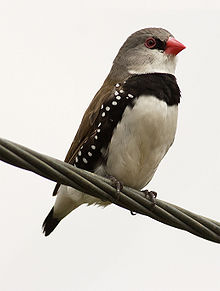- Diamond Firetail
-
Diamond Firetail 
Conservation status Scientific classification Kingdom: Animalia Phylum: Chordata Class: Aves Order: Passeriformes Family: Estrildidae Genus: Stagonopleura Species: S. guttata Binomial name Stagonopleura guttata
(Shaw, 1796)The Diamond Firetail Stagonopleura guttata is a species of estrildid finch found in eastern Australia, from Eyre Peninsula, South Australia, to south-eastern Queensland, commonly found on the slopes of the Great Dividing Range. The bird lives in eucalypt forest and woodland, mallee country, farmlands and grasslands. The bird spends significant amount of time on the ground finding seeds and insects.
Contents
Description
The Diamond Firetail is a finch that has a fiery red bill, eyes, and rump. Just below the throat, it has a thick black band that extends horizontally until it reaches the lower part of the wings which are also black with white spots. There is also a black eye band that starts at the beak and ends right at the eye. The bird's tail is also black. The rest of the wings are a slightly tan, light brown color. Its head and back is light gray and its belly and chin are white. The color of the egg is also white. This bird is considered one of the smallest of the finches.
Song
The male song is similar to a low raspy mating call. The male will hold a piece of dried grass in his mouth and hop up and down while singing on the perch.
Threats
Diamond Firetail's habitat has been threatened by alteration of vegetation structure caused by over-grazing, weed invasion, salinization and other flow-on processes. This loss of main food plants and habitat caused competition with invasive species, and predation of adults or young of Diamond Firetail.
Breeding
The nest is put together by both the male and the female, but only the female does the weaving. They like creating their own nests, not having one made for them. They use different materials such as coconut fibers, shredded paper, dried grass, and feathers. Diamond Firetails have been known to breed from September to the end of April and August to January in the wild. As mentioned earlier, the male gets the female's attention by holding a piece of dead grass in his beak while singing and bobbing up and down. They normally breed in the privacy of the nest or somewhere secluded and close to the ground. After breeding, the female egg can lay about 4 to 6 eggs and incubates them along with the male for 14 days. About 21 days after hatching, they will leave the nest and just about 21 days after that, they are weaned and become independent. Both the male and the female feed the young. Female Diamond Firetails can start breeding after 9 to 12 months of life and are best when paired at a young age. Their life span is usually between 5 to 7 years.
Food
Lettuce, spinach, chickweed, spray millet, eggfood, broccoli tops, sprouted seed, meal worms, small cockroaches, small crickets, hulled oats and carrot tops. In the wild, they eat ripe or partially ripe fruits and their seeds. They also eat some insects and their larvae.
Mutations
There are few mutations in the Diamond Firetail, however, one mutation produces an orange tail, instead of the fiery red, in this case the bird is known as the Yellow Diamond. Other mutations are the Pied Diamond which has splashes of white, the White Diamond, and the Fawn Diamond.
Sundown NP, S Queensland, Australia
Origin
Origin and phylogeny has been obtained by Antonio Arnaiz-Villena et al.[1] Estrildinae may have originated in India and dispersed thereafter (towards Africa and Pacific Ocean habitats).
References
- ^ Arnaiz-Villena, A; Ruiz-del-Valle V, Gomez-Prieto P, Reguera R, Parga-Lozano C, Serrano-Vela I (2009). "Estrildinae Finches (Aves, Passeriformes) from Africa, South Asia and Australia: a Molecular Phylogeographic Study". The Open Ornithology Journal 2: 29–36. http://chopo.pntic.mec.es/biolmol/publicaciones/Estrildinae_finches_2009.pdf.
- BirdLife Species Factsheet
- http://www.singing-wings-aviary.com/Diamond%20Firetails.htm
- http://www.birdsinbackyards.net/finder/display.cfm?id=317
- http://www.finchsociety.org/fsa/diamond/diamond.htm
- http://www.finchinfo.com/birds/finches/species/diamond_firetail_finch.php
- http://www.birdcare.com.au/diamond_firetail_finch.htm
External links
Categories:- IUCN Red List near threatened species
- Estrildidae
- Birds of South Australia
Wikimedia Foundation. 2010.

